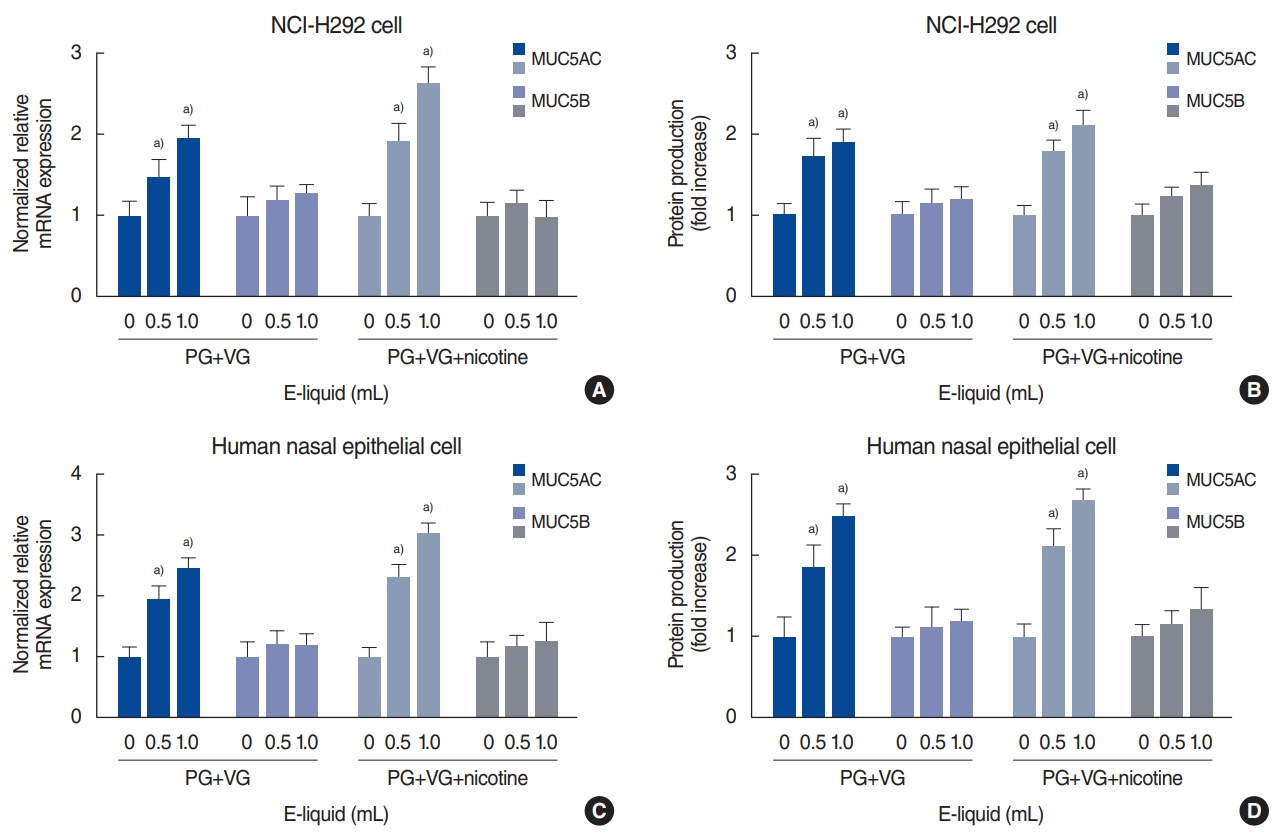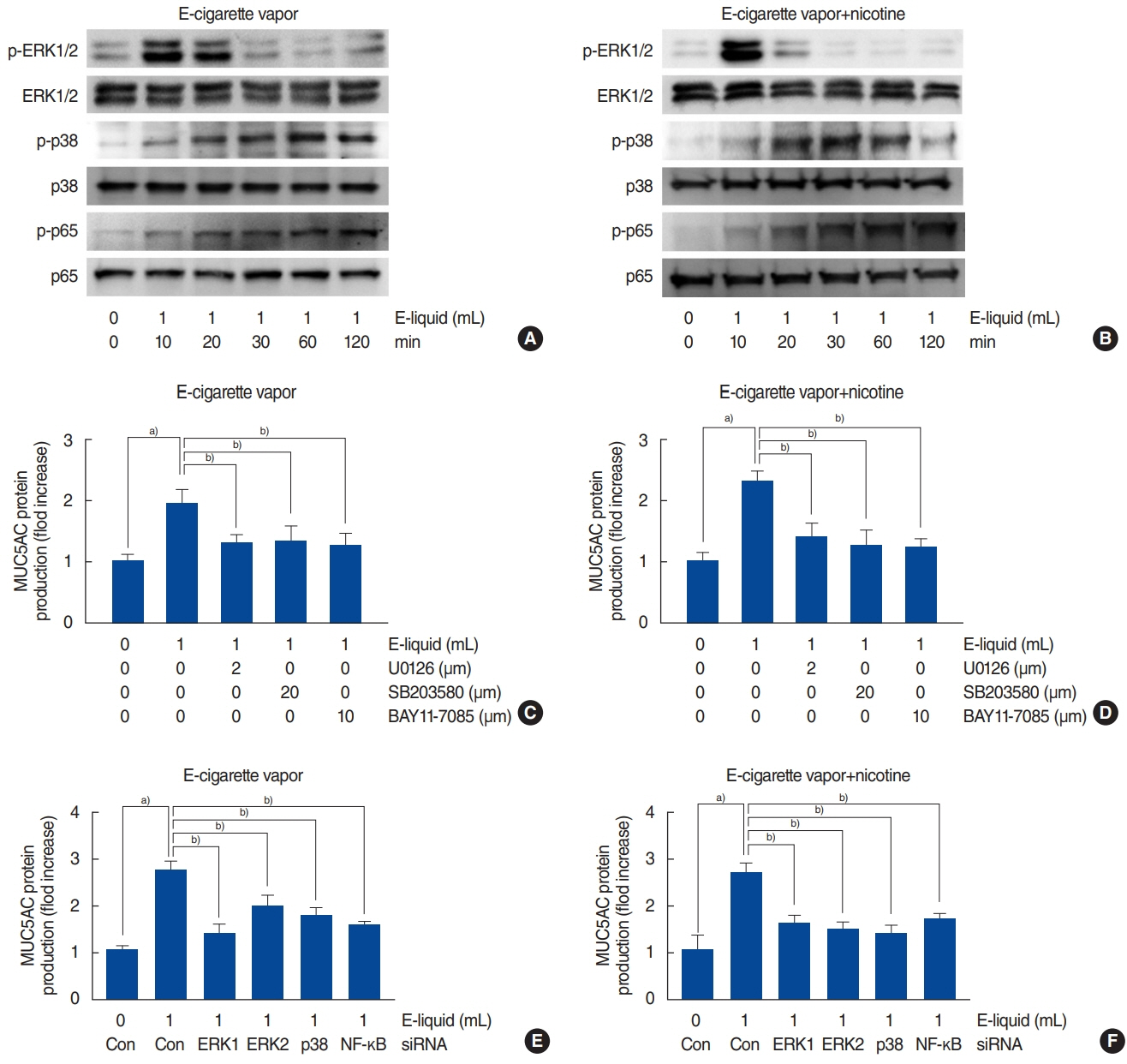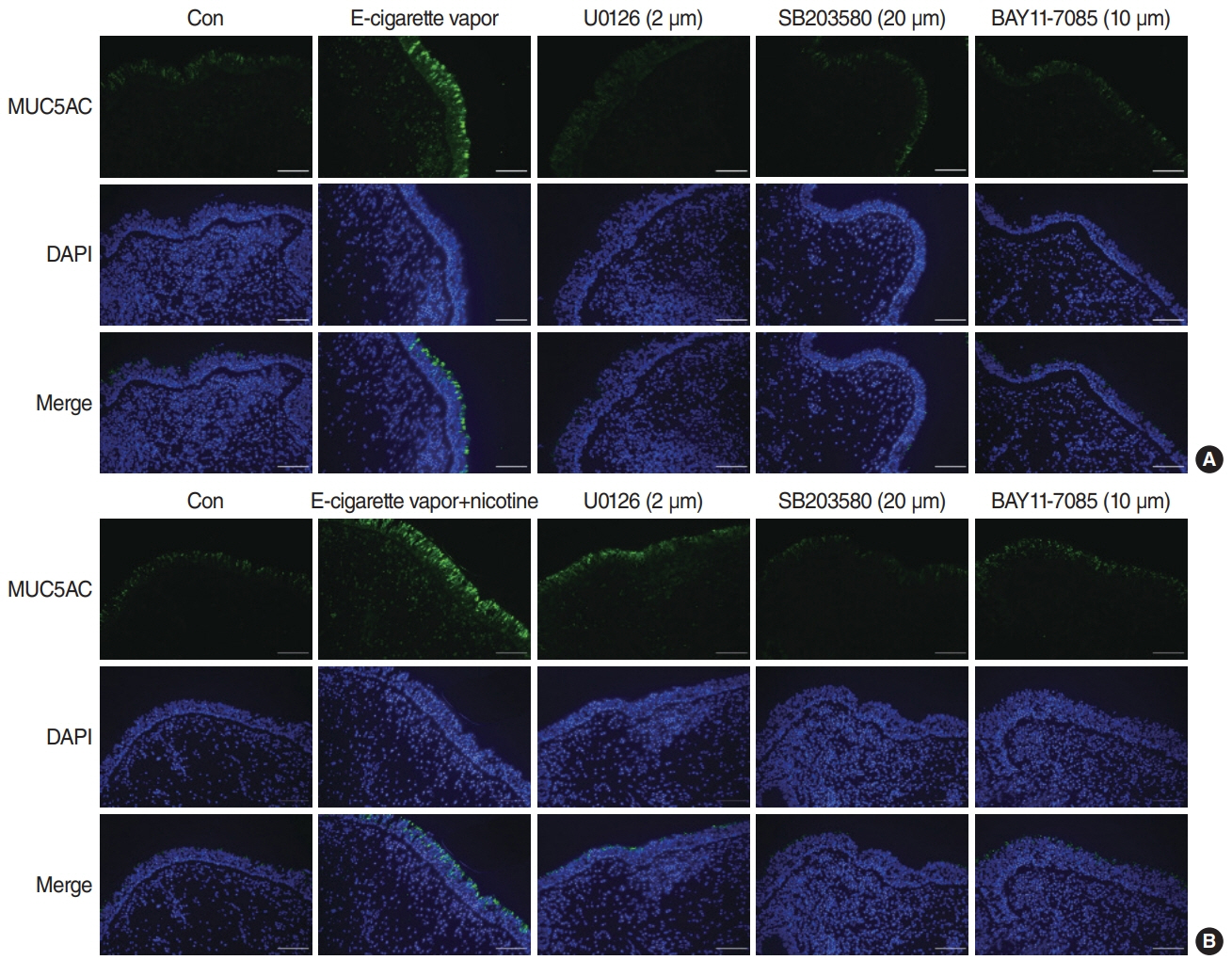Clin Exp Otorhinolaryngol.
2021 Aug;14(3):303-311. 10.21053/ceo.2020.01907.
Changes in Mucin Production in Human Airway Epithelial Cells After Exposure to Electronic Cigarette Vapor With or Without Nicotine
- Affiliations
-
- 1Department of Otorhinolaryngology-Head and Neck Surgery, Yeungnam University College of Medicine, Daegu, Korea
- 2Department of Medical Science, Yeungnam University College of Medicine, Daegu, Korea
- 3Regional Center for Respiratory Diseases, Yeungnam University Medical Center, Daegu, Korea
- KMID: 2519185
- DOI: http://doi.org/10.21053/ceo.2020.01907
Abstract
Objectives
. The emergence of electronic cigarettes (e-cigarettes) has created new perceptions of the tobacco market. Unlike traditional tobacco, the greatest advantage of e-cigarettes is that they have less smell and are convenient and inexpensive. Most e-cigarette smokers believe that e-cigarette smoking is less harmful than traditional smoking. Information on the effects of e-cigarettes on human health is limited, and the issue remains controversial.
Methods
. We studied the effects of e-cigarette vapor on mucin (MUC5AC and MUC5B) and the change of MUC5AC and MUC5B from e-cigarette liquid with or without nicotine in respiratory epithelial cells. The effects of e-cigarette vapor with or without nicotine on mucin, along with the involved signaling pathways, were investigated using reverse transcriptase-polymerase chain reaction (PCR), real-time PCR, enzyme immunoassays, and immunoblot analysis with several specific inhibitors and small interfering RNA.
Results
. E-cigarette vapor with or without nicotine stimulated MUC5AC, but not MUC5B, expression in respiratory epithelial cells. In addition, we showed that e-cigarette vapor with and without nicotine induced MUC5AC expression via activation of the mitogen-activated protein kinase (MAPK; extracellular signal-regulated kinase [ERK] 1/2 and p38) and nuclear factor kappa-light-chain-enhancer of activated B cells (NF-κB) signaling pathways in human airway epithelial cells.
Conclusion
. E-cigarette vapor with and with nicotine significantly increased MUC5AC expression in human airway epithelial cells.
Figure
Cited by 2 articles
-
Are Electronic Cigarettes Harmful? Mucin May Be the Key
Min-Seok Rha, Chang-Hoon Kim
Clin Exp Otorhinolaryngol. 2021;14(3):249-250. doi: 10.21053/ceo.2021.00906.Ghrelin Downregulates Lipopolysaccharide/ Leptin-Induced MUC5AC Expression in Human Nasal Epithelial Cells
Yoon Seok Choi, Hyung Gyun Na, Chang Hoon Bae, Si-Youn Song, Yong-Dae Kim
Clin Exp Otorhinolaryngol. 2023;16(1):49-58. doi: 10.21053/ceo.2022.00857.
Reference
-
1. Thornton SL, Oller L, Sawyer T. Fatal intravenous injection of electronic nicotine delivery system refilling solution. J Med Toxicol. 2014; Jun. 10(2):202–4.
Article2. Chen EY, Sun A, Chen CS, Mintz AJ, Chin WC. Nicotine alters mucin rheological properties. Am J Physiol Lung Cell Mol Physiol. 2014; Jul. 307(2):L149–57.
Article3. Kozlowski LT, Dreschel NA, Stellman SD, Wilkenfeld J, Weiss EB, Goldberg ME. An extremely compensatible cigarette by design: documentary evidence on industry awareness and reactions to the Barclay filter design cheating the tar testing system. Tob Control. 2005; Feb. 14(1):64–70.
Article4. Farsalinos KE, Romagna G, Tsiapras D, Kyrzopoulos S, Voudris V. Evaluation of electronic cigarette use (vaping) topography and estimation of liquid consumption: implications for research protocol standards definition and for public health authorities’ regulation. Int J Environ Res Public Health. 2013; Jun. 10(6):2500–14.
Article5. Wu Q, Jiang D, Minor M, Chu HW. Electronic cigarette liquid increases inflammation and virus infection in primary human airway epithelial cells. PLoS One. 2014; Sep. 9(9):e108342.
Article6. Farsalinos KE, Romagna G, Allifranchini E, Ripamonti E, Bocchietto E, Todeschi S, et al. Comparison of the cytotoxic potential of cigarette smoke and electronic cigarette vapour extract on cultured myocardial cells. Int J Environ Res Public Health. 2013; Oct. 10(10):5146–62.7. Martey CA, Pollock SJ, Turner CK, O’Reilly KM, Baglole CJ, Phipps RP, et al. Cigarette smoke induces cyclooxygenase-2 and microsomal prostaglandin E2 synthase in human lung fibroblasts: implications for lung inflammation and cancer. Am J Physiol Lung Cell Mol Physiol. 2004; Nov. 287(5):L981–91.
Article8. Farsalinos KE, Romagna G, Tsiapras D, Kyrzopoulos S, Voudris V. Evaluating nicotine levels selection and patterns of electronic cigarette use in a group of “vapers” who had achieved complete substitution of smoking. Subst Abuse. 2013; Sep. 7:139–46.
Article9. Kwak S, Kim YD, Na HG, Bae CH, Song SY, Choi YS. Resistin upregulates MUC5AC/B mucin gene expression in human airway epithelial cells. Biochem Biophys Res Commun. 2018; May. 499(3):655–61.
Article10. Reidel B, Radicioni G, Clapp PW, Ford AA, Abdelwahab S, Rebuli ME, et al. E-cigarette use causes a unique innate immune response in the lung, involving increased neutrophilic activation and altered mucin secretion. Am J Respir Crit Care Med. 2018; Feb. 197(4):492–501.
Article11. Ghosh A, Coakley RC, Mascenik T, Rowell TR, Davis ES, Rogers K, et al. Chronic e-cigarette exposure alters the human bronchial epithelial proteome. Am J Respir Crit Care Med. 2018; Jul. 198(1):67–76.
Article12. Alexander DJ, Collins CJ, Coombs DW, Gilkison IS, Hardy CJ, Healey G, et al. Association of Inhalation Toxicologists (AIT) working party recommendation for standard delivered dose calculation and expression in non-clinical aerosol inhalation toxicology studies with pharmaceuticals. Inhal Toxicol. 2008; Oct. 20(13):1179–89.
Article13. Renne RA, Wehner AP, Greenspan BJ, Deford HS, Ragan HA, Westerberg RB, et al. 2-Week and 13-week inhalation studies of aerosolized glycerol in rats. Inhal Toxicol. 1992; 4(2):95–111.
Article14. Lechasseur A, Jubinville E, Routhier J, Berube JC, Hamel-Auger M, Talbot M, et al. Exposure to electronic cigarette vapors affects pulmonary and systemic expression of circadian molecular clock genes. Physiol Rep. 2017; Oct. 5(19):e13440.
Article15. Lerner CA, Rutagarama P, Ahmad T, Sundar IK, Elder A, Rahman I. Electronic cigarette aerosols and copper nanoparticles induce mitochondrial stress and promote DNA fragmentation in lung fibroblasts. Biochem Biophys Res Commun. 2016; Sep. 477(4):620–5.
Article16. Garcia-Arcos I, Geraghty P, Baumlin N, Campos M, Dabo AJ, Jundi B, et al. Chronic electronic cigarette exposure in mice induces features of COPD in a nicotine-dependent manner. Thorax. 2016; Dec. 71(12):1119–29.
Article17. Schweitzer KS, Chen SX, Law S, Van Demark M, Poirier C, Justice MJ, et al. Endothelial disruptive proinflammatory effects of nicotine and e-cigarette vapor exposures. Am J Physiol Lung Cell Mol Physiol. 2015; Jul. 309(2):L175–87.
Article18. Margham J, McAdam K, Forster M, Liu C, Wright C, Mariner D, et al. Chemical composition of aerosol from an e-cigarette: a quantitative comparison with cigarette smoke. Chem Res Toxicol. 2016; Oct. 29(10):1662–78.
Article19. Goniewicz ML, Knysak J, Gawron M, Kosmider L, Sobczak A, Kurek J, et al. Levels of selected carcinogens and toxicants in vapour from electronic cigarettes. Tob Control. 2014; Mar. 23(2):133–9.
Article20. Hiemstra PS, Bals R. Basic science of electronic cigarettes: assessment in cell culture and in vivo models. Respir Res. 2016; Oct. 17(1):127.
Article21. Kaur G, Pinkston R, Mclemore B, Dorsey WC, Batra S. Immunological and toxicological risk assessment of e-cigarettes. Eur Respir Rev. 2018; Feb. 27(147):170119.
Article
- Full Text Links
- Actions
-
Cited
- CITED
-
- Close
- Share
- Similar articles
-
- Eriodictyol Inhibits the Production and Gene Expression of MUC5AC Mucin via the IκBα-NF-κB p65 Signaling Pathway in Airway Epithelial Cells
- Effects of Curcumin and Genistein on Phorbol Ester or Tumor Necrosis Factor-alpha-Induced Mucin Production from Human Airway Epithelial Cells
- Roxithromycin Suppresses MUC5B/8 Mucin Genes and Mucin Production in Airway Epithelial Cells
- Effects of Homogentisic Acid and Natural Products Derived from Pinellia ternata on Secretion, Production and Gene Expression of MUC5AC Mucin from Cultured Airway Epithelial Cells
- A Case Report of Acute Nicotine Poisoning from Subcutaneous Injection of Nicotine Solution for Electronic Cigarette





